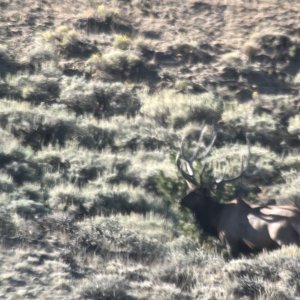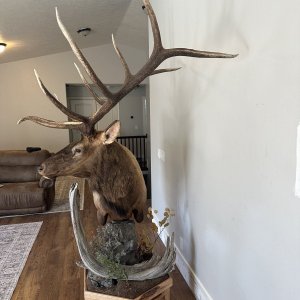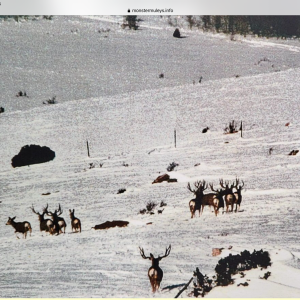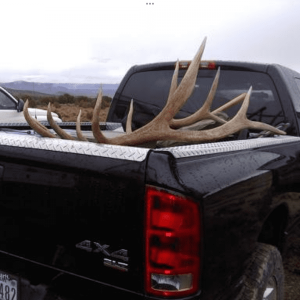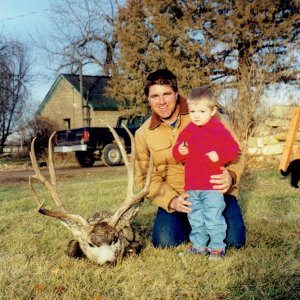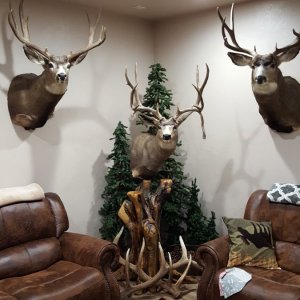johnnyp
New Member
- Messages
- 1
Capturing the Essence of Mule Deer: How Taxidermy Brings Nature into Your Home
Mule deer are majestic animals that roam the western United States and Canada, prized by hunters and nature enthusiasts alike. Taxidermy allows us to capture the essence of these creatures and bring a piece of nature into our homes. Whether you are an avid hunter or simply appreciate the beauty of wildlife, mule deer taxidermy can be a stunning addition to your home décor. In this article, we will explore the world of mule deer taxidermy, from the art of preserving these animals to the different types of mounts available, as well as tips for displaying and caring for your taxidermy collection.
Introduction to Mule Deer Taxidermy

Mule deer are majestic creatures that are known for their impressive antlers and distinctive appearance. It’s no wonder why so many hunters and nature enthusiasts are drawn to them. For those who want to bring a piece of nature into their home, mule deer taxidermy makes it possible to capture the essence of these beautiful creatures and display them with pride.
What is Mule Deer Taxidermy?
Taxidermy is the practice of preserving an animal's body for display or study. Mule deer taxidermy specifically refers to the process of preserving these particular deer species for decorative or practical purposes.
A Brief History of Mule Deer Taxidermy
Taxidermy has been practiced since ancient times, with early examples dating back to ancient civilizations such as Egypt and China. However, modern taxidermy as we know it today began to emerge in the 18th and 19th centuries.
In North America, taxidermy became popular in the late 1800s as people began to appreciate the beauty of native wildlife. Mule deer taxidermy in particular gained popularity during the mid-20th century as hunting and outdoor recreation became more common.
The Art of Preserving Mule Deer
Preserving a mule deer for taxidermy is a delicate process that takes great skill and precision. Here’s a closer look at what goes into creating a stunning mule deer mount.
The Taxidermy Process
The taxidermy process typically involves several steps, including skinning, cleaning, stuffing, and mounting. During the skinning process, the taxidermist carefully removes the deer’s skin and separates it from the flesh. The skin is then cleaned, disinfected, and treated to prevent decay.
Once the skin is prepared, the taxidermist stuffs it with a special material to give the mount its shape and form. Finally, the skin is mounted onto a mannequin or form to create a lifelike representation of the animal.
Tools and Materials
Taxidermy requires a wide range of tools and materials, including scalpels, forceps, sewing needles, and synthetic stuffing materials. Taxidermists also use a variety of chemicals and preservatives to treat and protect the skin.
Challenges and Solutions
Mule deer taxidermy can be challenging due to the unique shape and features of these animals. For example, their large antlers can be difficult to mount properly, and their unique facial features require careful attention to detail in order to create an accurate representation.
To overcome these challenges, taxidermists rely on years of experience and expertise, as well as specialized tools and techniques specifically designed for mounting mule deer.
Choosing the Right Mule Deer Mount for Your Home
Once you’ve decided to display a mule deer mount in your home, there are several factors to consider when choosing the right one for your space.
Full Mounts vs. Shoulder Mounts
Full mounts are a popular option for those who want to display the entire deer. These mounts typically include the entire body of the animal, complete with a realistic base.
Shoulder mounts, on the other hand, focus on the head and shoulders of the deer. These mounts are more compact and are ideal for smaller spaces or those who want to showcase the animal’s impressive antlers.
Size and Positioning
When choosing a mule deer mount, it’s important to consider the size and positioning of the animal. Larger mounts may be more impressive, but they can also take up a lot of space. Similarly, the positioning of the mount should be carefully considered to ensure that it fits well within your home's aesthetic.
Matching Your Home Décor
Finally, it’s important to choose a mule deer mount that complements your home's style and décor. Whether you prefer a more traditional or modern look, there are plenty of options available to suit your taste.
Mule Deer Hunting and Taxidermy: A Timeless Tradition
For many hunters, mule deer hunting and taxidermy go hand-in-hand. Here’s a closer look at the connection between these two beloved traditions.
The Connection Between Hunting and Taxidermy
Hunting for mule deer is a popular pastime, and many hunters choose to preserve their trophies through taxidermy. For these individuals, a mule deer mount serves as a reminder of their successful hunt and a symbol of their love for the outdoors.
Mule Deer Hunting Tips
If you’re interested in hunting mule deer, there are several tips to keep in mind. These include scouting your hunting area in advance, using scent control techniques, and being patient.
Preparing Your Mule Deer for Taxidermy
If you plan on preserving your mule deer through taxidermy, it’s important to take proper care of the animal after the hunt. This includes properly field-dressing the deer to prevent spoilage and damage to the skin. With proper care, you can ensure that your mule deer mount will be a beautiful and lasting reminder of your hunting experience.Displaying Mule Deer Mounts: Tips and Techniques
Bringing the great outdoors into your home with a mule deer taxidermy mount is a unique and exciting way to showcase your passion for hunting and nature. However, displaying your mount requires careful consideration and planning to ensure it's showcased in the best possible way. Here are some tips and techniques to help you create a natural and visually captivating display for your mule deer mount.
Choosing the Right Display Location
First and foremost, consider where the mount will be displayed in your home. The location should not only accommodate the size of the mount but also provide ample viewing space and the appropriate lighting. Ideally, the mount should be placed in an area where it will not be exposed to excessive heat, humidity, or direct sunlight.
Lighting and Framing
Lighting is key to showcasing your mule deer mount in the best possible way. Consider using accent lighting or spotlights to draw attention to the mount and highlight its unique features. Additionally, framing the mount with a natural-looking backdrop, such as a forest scene or mountain landscape, can enhance the overall effect and create a striking visual display.
Creating a Natural Setting
To create a natural setting for your mule deer mount, consider incorporating elements such as rocks, foliage, or even a small stream or pond into the display. These elements can help to further enhance the natural beauty of the mount and create a more immersive and visually engaging display.
Caring for Your Mule Deer Taxidermy: Maintenance and Preservation
Proper care and maintenance are essential for preserving the beauty and integrity of your mule deer taxidermy mount. Here are some tips to help you keep your mount looking its best for years to come.
Keeping Your Mule Deer Clean
To keep your mule deer mount clean, avoid using any harsh chemicals or cleaning agents. Instead, use a soft-bristled brush or cloth to gently dust the mount. If the mount becomes soiled, use a damp cloth to gently wipe away any dirt or debris.
Preventing Damage and Decay
Mule deer mounts are susceptible to damage and decay if not properly cared for. To prevent damage, avoid touching the mount with bare hands, as the oils on your skin can be corrosive to the fur and hide. Additionally, be sure to protect the mount from insects, such as moths, by using mothballs or other insect repellents.
Professional Restoration and Repair
If your mule deer taxidermy mount becomes damaged or begins to show signs of decay, it's important to seek the assistance of a professional taxidermist. A trained taxidermist can repair or restore your mount to its original beauty and ensure it continues to be a cherished piece in your home for years to come.
Beyond the Mount: Creative Uses for Mule Deer Antlers
Mule deer antlers are not only prized by hunters and taxidermists but also sought after by crafters, decorators, and fashionistas. Here are some creative and unique ways to incorporate mule deer antlers into your home and style.
Antler Crafts and DIY Projects
Mule deer antlers can be used in a variety of DIY craft projects, such as creating decorative wreaths, candle holders, or even chandeliers. The unique shape and texture of antlers make them a versatile and visually interesting material for a range of craft projects.
Antlers in Home Decor
Mule deer antlers can also be incorporated into home decor in a variety of creative ways. For example, antlers can be used as a decorative element in a rustic-themed room or as an accent piece in a minimalist space. Additionally, antlers can be used to create unique wall art or even as a functional coat rack.
Antlers in Fashion and Accessories
Mule deer antlers have also become a popular material in the fashion world, with designers incorporating antlers into everything from jewelry to handbags. The unique and natural beauty of antlers makes them a captivating and eye-catching accessory for any outfit.
Conclusion: The Beauty and Significance of Mule Deer Taxidermy
Mule deer taxidermy not only celebrates the beauty and majesty of these magnificent animals but also serves as a symbol of our connection to the natural world. Whether displayed in your home, incorporated into craft projects, or used as a fashion accessory, mule deer taxidermy and antlers hold a special significance and beauty that cannot be found in any other material.
Mule Deer Taxidermy as Art
Mule deer taxidermy is not just a display, but a work of art that requires skill, precision, and an eye for detail. The craftsmanship and dedication that go into creating a mule deer mount are a testament to the value and significance that these animals hold in our lives.
The Importance of Wildlife Conservation
Finally, it's important to remember that mule deer taxidermy and antlers are a reminder of the importance of wildlife conservation. By supporting ethical hunting practices and responsible wildlife management, we can ensure that future generations will be able to appreciate and enjoy the natural beauty and significance of mule deer and other wildlife for years to come.In conclusion, mule deer taxidermy is a beautiful and timeless tradition that allows us to appreciate the majesty of these creatures in our own homes. Whether you are an experienced hunter or simply a lover of nature, a mule deer mount can be a stunning addition to your home décor. By following the tips and techniques outlined in this article, you can ensure your mule deer taxidermy collection remains in pristine condition for years to come.
Frequently Asked Questions
Is it legal to own a mule deer mount?
Yes, it is legal to own a mule deer mount as long as it was obtained legally through hunting or purchased from a licensed taxidermist. However, it is important to check your state and local laws regarding the possession and display of wildlife.
How long does the taxidermy process take?
The taxidermy process can take several months, depending on the complexity of the mount and the workload of the taxidermist. It is important to choose a reputable and experienced taxidermist who can provide a realistic timeline based on their current workload.
How do I care for my mule deer mount?
To care for your mule deer mount, it is important to keep it clean and dust-free. Use a soft cloth or brush to remove any dirt or debris, and avoid exposing it to direct sunlight or moisture. In addition, it is recommended to have your mount professionally cleaned and maintained every few years.
What should I do if my mount becomes damaged?
If your mount becomes damaged, it is important to have it repaired as soon as possible by a professional taxidermist. Do not attempt to repair the damage yourself, as this can cause further damage and potentially ruin the mount. A reputable taxidermist can assess the damage and provide a solution for restoration or repair.
Mule deer are majestic animals that roam the western United States and Canada, prized by hunters and nature enthusiasts alike. Taxidermy allows us to capture the essence of these creatures and bring a piece of nature into our homes. Whether you are an avid hunter or simply appreciate the beauty of wildlife, mule deer taxidermy can be a stunning addition to your home décor. In this article, we will explore the world of mule deer taxidermy, from the art of preserving these animals to the different types of mounts available, as well as tips for displaying and caring for your taxidermy collection.
Introduction to Mule Deer Taxidermy
Mule deer are majestic creatures that are known for their impressive antlers and distinctive appearance. It’s no wonder why so many hunters and nature enthusiasts are drawn to them. For those who want to bring a piece of nature into their home, mule deer taxidermy makes it possible to capture the essence of these beautiful creatures and display them with pride.
What is Mule Deer Taxidermy?
Taxidermy is the practice of preserving an animal's body for display or study. Mule deer taxidermy specifically refers to the process of preserving these particular deer species for decorative or practical purposes.
A Brief History of Mule Deer Taxidermy
Taxidermy has been practiced since ancient times, with early examples dating back to ancient civilizations such as Egypt and China. However, modern taxidermy as we know it today began to emerge in the 18th and 19th centuries.
In North America, taxidermy became popular in the late 1800s as people began to appreciate the beauty of native wildlife. Mule deer taxidermy in particular gained popularity during the mid-20th century as hunting and outdoor recreation became more common.
The Art of Preserving Mule Deer
Preserving a mule deer for taxidermy is a delicate process that takes great skill and precision. Here’s a closer look at what goes into creating a stunning mule deer mount.
The Taxidermy Process
The taxidermy process typically involves several steps, including skinning, cleaning, stuffing, and mounting. During the skinning process, the taxidermist carefully removes the deer’s skin and separates it from the flesh. The skin is then cleaned, disinfected, and treated to prevent decay.
Once the skin is prepared, the taxidermist stuffs it with a special material to give the mount its shape and form. Finally, the skin is mounted onto a mannequin or form to create a lifelike representation of the animal.
Tools and Materials
Taxidermy requires a wide range of tools and materials, including scalpels, forceps, sewing needles, and synthetic stuffing materials. Taxidermists also use a variety of chemicals and preservatives to treat and protect the skin.
Challenges and Solutions
Mule deer taxidermy can be challenging due to the unique shape and features of these animals. For example, their large antlers can be difficult to mount properly, and their unique facial features require careful attention to detail in order to create an accurate representation.
To overcome these challenges, taxidermists rely on years of experience and expertise, as well as specialized tools and techniques specifically designed for mounting mule deer.
Choosing the Right Mule Deer Mount for Your Home
Once you’ve decided to display a mule deer mount in your home, there are several factors to consider when choosing the right one for your space.
Full Mounts vs. Shoulder Mounts
Full mounts are a popular option for those who want to display the entire deer. These mounts typically include the entire body of the animal, complete with a realistic base.
Shoulder mounts, on the other hand, focus on the head and shoulders of the deer. These mounts are more compact and are ideal for smaller spaces or those who want to showcase the animal’s impressive antlers.
Size and Positioning
When choosing a mule deer mount, it’s important to consider the size and positioning of the animal. Larger mounts may be more impressive, but they can also take up a lot of space. Similarly, the positioning of the mount should be carefully considered to ensure that it fits well within your home's aesthetic.
Matching Your Home Décor
Finally, it’s important to choose a mule deer mount that complements your home's style and décor. Whether you prefer a more traditional or modern look, there are plenty of options available to suit your taste.
Mule Deer Hunting and Taxidermy: A Timeless Tradition
For many hunters, mule deer hunting and taxidermy go hand-in-hand. Here’s a closer look at the connection between these two beloved traditions.
The Connection Between Hunting and Taxidermy
Hunting for mule deer is a popular pastime, and many hunters choose to preserve their trophies through taxidermy. For these individuals, a mule deer mount serves as a reminder of their successful hunt and a symbol of their love for the outdoors.
Mule Deer Hunting Tips
If you’re interested in hunting mule deer, there are several tips to keep in mind. These include scouting your hunting area in advance, using scent control techniques, and being patient.
Preparing Your Mule Deer for Taxidermy
If you plan on preserving your mule deer through taxidermy, it’s important to take proper care of the animal after the hunt. This includes properly field-dressing the deer to prevent spoilage and damage to the skin. With proper care, you can ensure that your mule deer mount will be a beautiful and lasting reminder of your hunting experience.Displaying Mule Deer Mounts: Tips and Techniques
Bringing the great outdoors into your home with a mule deer taxidermy mount is a unique and exciting way to showcase your passion for hunting and nature. However, displaying your mount requires careful consideration and planning to ensure it's showcased in the best possible way. Here are some tips and techniques to help you create a natural and visually captivating display for your mule deer mount.
Choosing the Right Display Location
First and foremost, consider where the mount will be displayed in your home. The location should not only accommodate the size of the mount but also provide ample viewing space and the appropriate lighting. Ideally, the mount should be placed in an area where it will not be exposed to excessive heat, humidity, or direct sunlight.
Lighting and Framing
Lighting is key to showcasing your mule deer mount in the best possible way. Consider using accent lighting or spotlights to draw attention to the mount and highlight its unique features. Additionally, framing the mount with a natural-looking backdrop, such as a forest scene or mountain landscape, can enhance the overall effect and create a striking visual display.
Creating a Natural Setting
To create a natural setting for your mule deer mount, consider incorporating elements such as rocks, foliage, or even a small stream or pond into the display. These elements can help to further enhance the natural beauty of the mount and create a more immersive and visually engaging display.
Caring for Your Mule Deer Taxidermy: Maintenance and Preservation
Proper care and maintenance are essential for preserving the beauty and integrity of your mule deer taxidermy mount. Here are some tips to help you keep your mount looking its best for years to come.
Keeping Your Mule Deer Clean
To keep your mule deer mount clean, avoid using any harsh chemicals or cleaning agents. Instead, use a soft-bristled brush or cloth to gently dust the mount. If the mount becomes soiled, use a damp cloth to gently wipe away any dirt or debris.
Preventing Damage and Decay
Mule deer mounts are susceptible to damage and decay if not properly cared for. To prevent damage, avoid touching the mount with bare hands, as the oils on your skin can be corrosive to the fur and hide. Additionally, be sure to protect the mount from insects, such as moths, by using mothballs or other insect repellents.
Professional Restoration and Repair
If your mule deer taxidermy mount becomes damaged or begins to show signs of decay, it's important to seek the assistance of a professional taxidermist. A trained taxidermist can repair or restore your mount to its original beauty and ensure it continues to be a cherished piece in your home for years to come.
Beyond the Mount: Creative Uses for Mule Deer Antlers
Mule deer antlers are not only prized by hunters and taxidermists but also sought after by crafters, decorators, and fashionistas. Here are some creative and unique ways to incorporate mule deer antlers into your home and style.
Antler Crafts and DIY Projects
Mule deer antlers can be used in a variety of DIY craft projects, such as creating decorative wreaths, candle holders, or even chandeliers. The unique shape and texture of antlers make them a versatile and visually interesting material for a range of craft projects.
Antlers in Home Decor
Mule deer antlers can also be incorporated into home decor in a variety of creative ways. For example, antlers can be used as a decorative element in a rustic-themed room or as an accent piece in a minimalist space. Additionally, antlers can be used to create unique wall art or even as a functional coat rack.
Antlers in Fashion and Accessories
Mule deer antlers have also become a popular material in the fashion world, with designers incorporating antlers into everything from jewelry to handbags. The unique and natural beauty of antlers makes them a captivating and eye-catching accessory for any outfit.
Conclusion: The Beauty and Significance of Mule Deer Taxidermy
Mule deer taxidermy not only celebrates the beauty and majesty of these magnificent animals but also serves as a symbol of our connection to the natural world. Whether displayed in your home, incorporated into craft projects, or used as a fashion accessory, mule deer taxidermy and antlers hold a special significance and beauty that cannot be found in any other material.
Mule Deer Taxidermy as Art
Mule deer taxidermy is not just a display, but a work of art that requires skill, precision, and an eye for detail. The craftsmanship and dedication that go into creating a mule deer mount are a testament to the value and significance that these animals hold in our lives.
The Importance of Wildlife Conservation
Finally, it's important to remember that mule deer taxidermy and antlers are a reminder of the importance of wildlife conservation. By supporting ethical hunting practices and responsible wildlife management, we can ensure that future generations will be able to appreciate and enjoy the natural beauty and significance of mule deer and other wildlife for years to come.In conclusion, mule deer taxidermy is a beautiful and timeless tradition that allows us to appreciate the majesty of these creatures in our own homes. Whether you are an experienced hunter or simply a lover of nature, a mule deer mount can be a stunning addition to your home décor. By following the tips and techniques outlined in this article, you can ensure your mule deer taxidermy collection remains in pristine condition for years to come.
Frequently Asked Questions
Is it legal to own a mule deer mount?
Yes, it is legal to own a mule deer mount as long as it was obtained legally through hunting or purchased from a licensed taxidermist. However, it is important to check your state and local laws regarding the possession and display of wildlife.
How long does the taxidermy process take?
The taxidermy process can take several months, depending on the complexity of the mount and the workload of the taxidermist. It is important to choose a reputable and experienced taxidermist who can provide a realistic timeline based on their current workload.
How do I care for my mule deer mount?
To care for your mule deer mount, it is important to keep it clean and dust-free. Use a soft cloth or brush to remove any dirt or debris, and avoid exposing it to direct sunlight or moisture. In addition, it is recommended to have your mount professionally cleaned and maintained every few years.
What should I do if my mount becomes damaged?
If your mount becomes damaged, it is important to have it repaired as soon as possible by a professional taxidermist. Do not attempt to repair the damage yourself, as this can cause further damage and potentially ruin the mount. A reputable taxidermist can assess the damage and provide a solution for restoration or repair.

